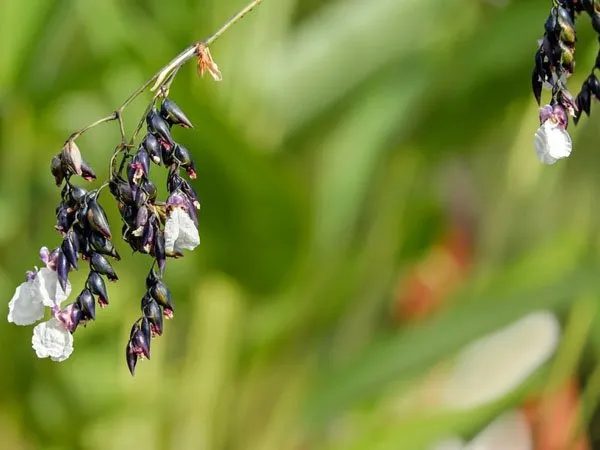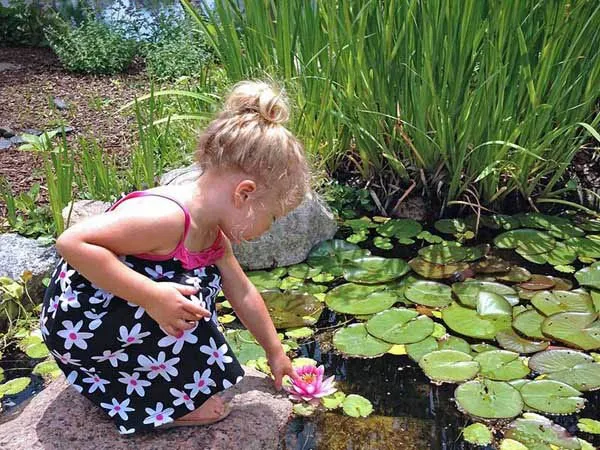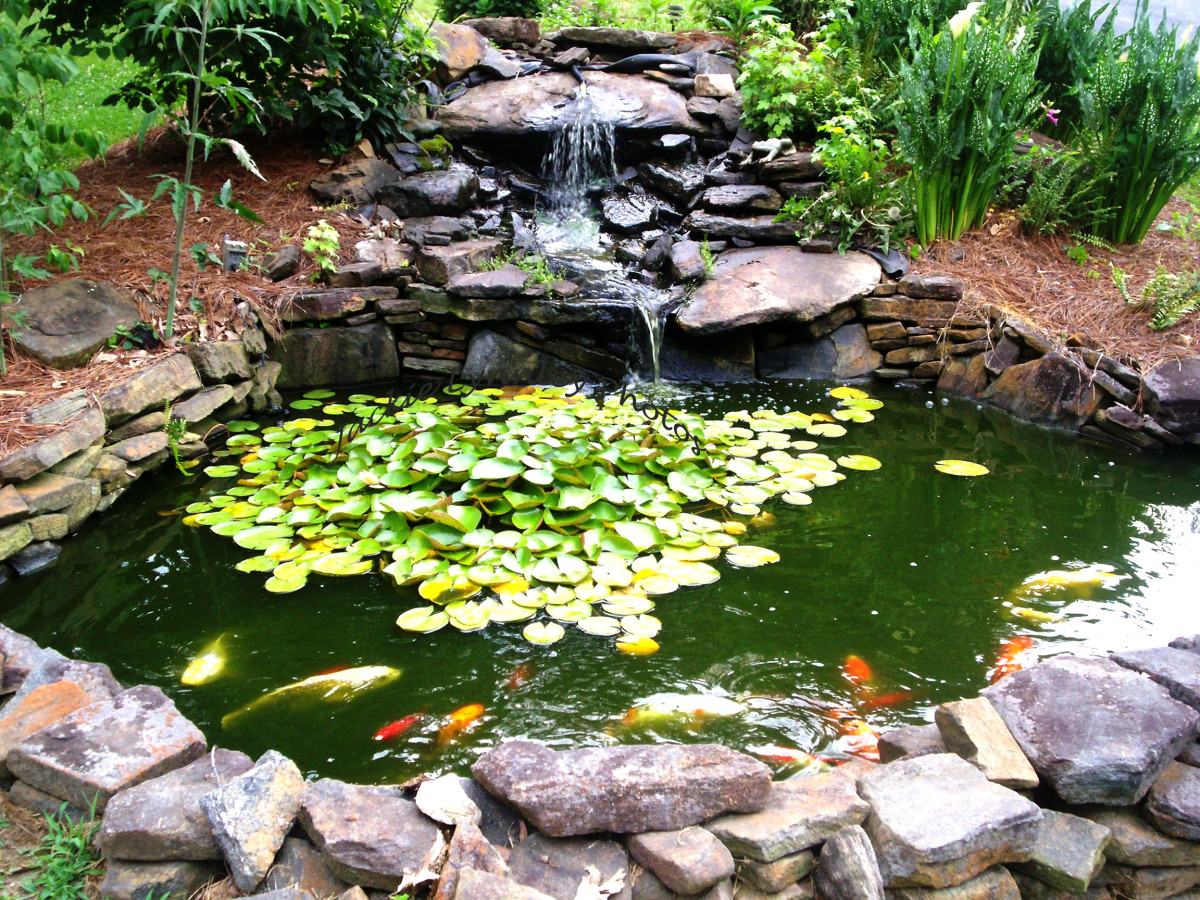A thriving, naturalistic goldfish pond contains a variety of aquatic plants to oxygenate the water, provide shelter, and keep parameters in check. While goldfish will nibble on some plant types others are untouched, creating a balanced environment. Consider adding a selection of the following top-performing plants to your goldfish pond.
Best Floating Plants
Floating at the water’s surface, these plants help control algae while offering protection and shade below. Popular choices include:
-
Water lilies – A traditional pond plant, water lilies float elegantly on the surface with rounded leaves and beautiful blooms. The roots nourish the pond.
-
Water lettuce – Its fuzzy, lettuce-like leaves spread readily to provide excellent cover. Easy to manage and clean up excess growth.
-
Duckweed – Tiny leaves float in masses, absorbing nutrients. Goldfish graze it but regrows rapidly. Keeps water clean.
-
Azolla – A tiny fern forming bright green carpets on the surface Filters water while deterring algae growth,
-
Water poppies – Cheery yellow flowers rest above lily pad style leaves. Roots oxygenate water. Tough and spreads nicely.
Best Marginal Plants
Growing along the water’s edge, marginal plants add beauty while stabilizing the bank. Consider:
-
Iris – Gorgeous blooms in spring and summer rest atop sword-like foliage. A pond classic that withstands nibbling.
-
Cattails – A natural look with upright strappy leaves. Roots filter water. Ideal for large ponds.
-
Sweet flag – Grass-like with green/variegated leaves. Spreads along shoreline. Soft parts nibbled when young.
-
Arrowhead – Arrow shaped leaves add lush texture. White flowers. Good for overflow ponds.Handles wet soils.
-
Pickerelweed – Spikes of purple flowers over heart-shaped leaves. Provides shade and natural filtration.
Best Submerged Plants
Growing underwater, submerged plants oxygenate the pond, offer shelter and get grazed by goldfish. Top options:
-
Anacharis – Fast growing with long green stems. Natural filtration. Grazed but regrows rapidly.
-
Hornwort – Feathery, bright green leaves provide dense cover. Submerged or floating. Quickly regrows.
-
Cabomba – Fluffy stems with feathery whorled leaves. Grows bushy, grazed often. Oxygenates well.
-
Parrot’s feather – Trailing stems with fern-like foliage. Can float too. Withstands eating.
-
Fanwort – Submerged rosettes of wide blades. Spreads nicely. Grazed but persists.
Best Oxygenating Plants
These fully submerged plants infuse oxygen into the water for healthy parameters. Consider:
-
Elodea – Common oxygenator with long stems and bright green leaves in whorls of three.
-
Foxtail – Dense bushy tails of thin green leaves. Withstands eating and grazed often.
-
Naiad – Graceful ribbons of slender leaves. Grows in clumps and spreads by runners.
-
Muskgrass – Fine, bright green threads. Unfussy plant grows well in pots.
-
Water milfoil – Feathery foliage on long stems that provide thick cover.
Best Algae-Reducing Plants
By absorbing excess nutrients in the water, these plants prevent explosive algae growth:
-
Water lettuce – Floating leaves cover the surface, blocking light for algae.
-
Duckweed – Tiny floating leaves spread in mats. Absorbs nutrients efficiently.
-
Water hyacinth – Lovely purple flowers with bulbous floating leaves to shade water.
-
Hornwort – Submerged feather-like foliage filters nutrients.
-
Water sprite – Delicate leaves grow floating or submerged to control nutrients.
Quick Tips for Planting
When introducing plants to your goldfish pond:
-
Select a variety of plant types to create a balanced ecosystem.
-
Plant in spring or summer when water temperatures are warmer.
-
Water lilies and lotus do best in pots so roots don’t take over.
-
Start with fewer plants, allowing them to establish before adding more.
-
Remove dead leaves/debris and thin aggressive growers to prevent overcrowding.
-
In cold climates, bring tropical plants indoors for winter once temps drop.
With the right selection and care of aquatic plants, your goldfish pond will not only look more lush and natural, but will thrive in better water quality and habitat.
Marginal Aquatic Pond Plants
Marginal aquatic plants for ponds grow where the water and land meet or in boggy areas. They aren’t interchangeable with bog plants because bog plants can’t grow in marginal areas.

Blue moneywort can add a nice splash of color to any pond. They love full sun or partly shady areas, so they can live around almost any pond.
The creeping jenny/golden moneywort is the more common of these aquatic plants for ponds. They’re great for filling in spaces between rocks and waterfalls as they grow in nice, thick mats.
Moneywort is a great plant for ponds because it grows in nice, thick mats that cover well and keep the soil from washing away. It can be used to fill in gaps between rocks and waterfalls.

Some of the most beautiful water plants for ponds bloom in the spring for a few weeks in shades of white, blue, pink, and more. There are a lot of them because they are 4 to 6 feet tall and only take up about half that much space.
People know that yellow iris plants can remove pollutants from water, which makes the pond’s water quality much better.

These late bloomers like to show their flowers in the later summer/early fall time. They also take up a lot of room—4 to 6 feet tall and 6 to 8 feet across. This violet-colored plant loves sunny areas.
Thalia pond plants not only make your garden look nicer from above, but they also bring in pollinators like bees and butterflies.
Discover The Underwater Garden: The Magic Of Aquatic Plants For Ponds

Have you ever thought about why some backyard ponds look like lush oasises and others look dull and lifeless? Or maybe you’re interested in how simple plants can turn a plain pond into a thriving ecosystem?
These posts will teach you about the various kinds of water plants that are good for ponds and how they are important for the health and beauty of the pond.
By the end of this article, you’ll not only have a list of our 11 favorite aquatic plants to use in your Maryland pond construction project, but you’ll also know why they’re so important for the water environment.
Best Plants for Goldfish (That They Won’t Destroy!)
FAQ
Which plant is best for goldfish?
Can you put plants with goldfish?
What plants are toxic to goldfish?
What plants grow in a goldfish pond?
It contributes to a healthy environment for underwater life. Marginal plants are essential for goldfish pond health. Moneywort, Yellow Iris, and Thalia grow well at the pond’s edge, offering habitat for wildlife and helping maintain water quality. Moneywort can grow in shallow water or damp soil and forms thick foliage.
Which plants are suitable for goldfish?
Certain plants are particularly suitable for goldfish, offering nutritional benefits. The Banana Plant (Nymphoides aquatica) is a nutritious plant that can grow in various water depths. Its roots not only add visual appeal but also aid in oxygenating and filtering the water.
Should you add plants to a goldfish pond?
Adding plants to a goldfish pond is essential for a healthy ecosystem. Plants oxygenate the water, feed goldfish, and act as natural filters to keep the environment balanced. Choosing the right plants is important for compatibility with goldfish and overall pond health. It’s necessary to mix floating, submerged, and marginal plants.
Why are goldfish pond plants important?
Pond plants are crucial for a healthy goldfish pond, providing water filtration, oxygenation, and habitats. They help keep the water clear by absorbing nutrients that would otherwise promote algae growth. This ensures good water quality and impacts both fish health and the look of the pond.
Are water poppy plants good for goldfish ponds?
Water poppy is a beautiful floating plant that is perfect for goldfish ponds. Its bright yellow flowers add a pop of color to your pond, and its lily pad-like leaves provide shade and shelter for your fish. Water poppy can be grown in full sun or partial shade and requires well-aerated water to thrive.
Are water lilies good for goldfish ponds?
Water lilies are a popular choice for goldfish ponds, and for good reason. These floating plants are not only visually appealing but also provide shade and protection for your fish. They come in a variety of colors, including white, pink, and yellow, and can grow to be quite large. Water lilies require full sun and well-aerated water to thrive.

